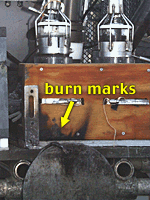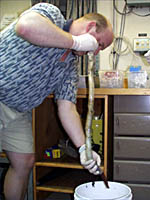

TODAY'S WEATHER
Cloudy
64°F (17.8°C)
Latitude: 27deg 0’ N
Longitude: 111deg 24’ W
Wind Direction: NW
Wind Speed: 16 Knots
Sea State:3
Swell(s) Height: 2 Feet
Sea Temperature: 67°F (19.5°C)
Barometric Pressure: 1016.6 MB
Visibility: 20 Nautical Miles
COMMENTS
-VARIETY OF HIGH CLOUDS, BORDERING ON OVERCAST
- SEAS LAID DOWN NICELY AFTER A LUMPY NIGHT
- VISIBILITY GOOD, BUT THE COAST OF BAJA IS PRETTY HAZY THIS MORNING

BREAKFAST
Mushroom and cheddar fritatta
Organic multi-grain cereal
Cheddar cheese frittata
Scrambled eggs
Blueberry pancakes
Homefries
Sausages
Bagels
Raspberry orange drop scones
LUNCH
Cream of tomato soup
Turkey a la king with rice
Cheeseburgers
Cauliflower and Cheddar quiche
Tatertots
Assorted chocolates
DINNER
Burrito & Taco Bar
Seasoned beef & chicken fajita strips
Black beans
Refried beans
Rice
Olives, tomato, onion, lettuce
Jalapenos
Green chile
Sour cream
Salsa
Salsa verde
Black Forest cake
Daily Update: Dive
3517
January 14, 2000
By Dr. Dan Fornari and Dr. Susan Humphris
There is great excitement on board tonight! Everyone
is zooming around, processing samples. The scientists are now attempting
to culture (grow) the microbes that they brought up from the hydrothermal
vents!
The seas calmed down quite a bit overnight. The partially cloudy sky resulted
in a spectacular sunrise. Anna-Louise Reysenbach and Don Nuzzio boarded Alvin at
0800 hrs this morning for Dive 3517. Their goal was to visit several vents and
collect samples for the biologists and chemists.
With Expedition Leader Pat Hickey as pilot, they visited five vent
areas and collected eight “Sipper” water samples, four
sulfide samples (two for molecular work on the microbes, and two
for culturing), three cores of sulfide-rich mud, and many vent animals.
During the day, everyone was busy with some activity. George Luther prepared
the chemical sensors for the next few dives. The tips of the sensors have to
be polished until they are smooth. George then adds a drop of mercury to the
end. This is a difficult job on a rolling and vibrating ship! Alice Ortman and
Melissa Kendall reviewed and analyzed the videotapes from yesterday's dive. On
deck, Jeff Benitz and Jerry Graham of the Deck Department got a little painting
done so the ship stays in good shape.
The weather got better as the day progressed. A pod of pilot whales visited us
in the afternoon. As usual, the crew recovered Alvin efficiently. Anna-Louise
and Don excitedly told the gathering scientists all about the bacterial mats
and hydrothermal vents they had seen. Pat was the first to notice burn marks
on the equipment at the front of the basket. Alvin had gotten too close
to a hot vent!
The excited scientists removed the samples from the basket and brought them into
the lab as quickly as possible. Once in the lab, Tim Shank pulled long tubeworms
from a bucket. Luis Hurtado put small segmented worms in tubes. Other scientists
collected material from the rocks so they could start culturing the microbes.
Some of the scientists will continue to work well into the night. Others will
get some sleep to prepare for the dive tomorrow.
Today was also the start of the cruise Ping-Pong tournament. There were several
matches today. The Ping-Pong table is in the main lab, so people who are not
working can enjoy a game and relax a bit. The competition is fierce. The ship’s
crew and the Alvin team have practiced hard! Check back to see who wins!
Dive Summary
On Bottom: 0919 hrs.
Off Bottom: 1505 hrs.
Maximum Depth: 2019 meters

Hydrothermal vents are hot! In this photo you can see black burn
marks on the gray plastic sample box and the wooden core holder.

Tim Shank sorts a bucket full of tubeworms collected on Dive 3517.

Hydrothermal fluid flows out of a sulfide structure.
Dive 3517 was very productive. Pilot Pat Hickey,
Anna-Louise, and Don found and sampled several hydrothermal sulfide
structures. Pat said that he was impressed by how many vent structures
there were in the area. "Every time we turned on
the scanning CTFM sonar, we saw targets, so it was easy to drive around and find
them." They were interested in sampling the ledges that protrude from the sides
of the sulfide structures. These ledges, composed of iron sulfide minerals and
barium sulfate (barite), trap pools of hot (300°C, 572°F) hydrothermal
fluid beneath them. Paralvinellid worms live on the surface of the ledges where
the temperatures are only 30-50°C (86-122°F). Microbes like living
in these cooler places on the ledges.
In addition to sampling these ledges, they took Sipper samples, made temperature
measurements, and used the chemical sensors to learn about the environment where
the microbes are living. They also collected several different types of worms
(including tubeworms and segmented worms) from some of the lower-temperature
vent sites.
|






